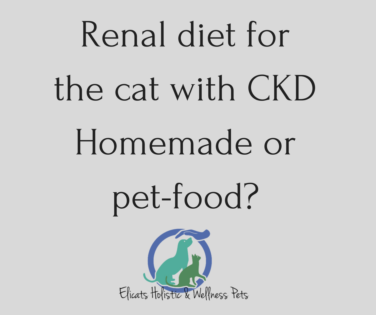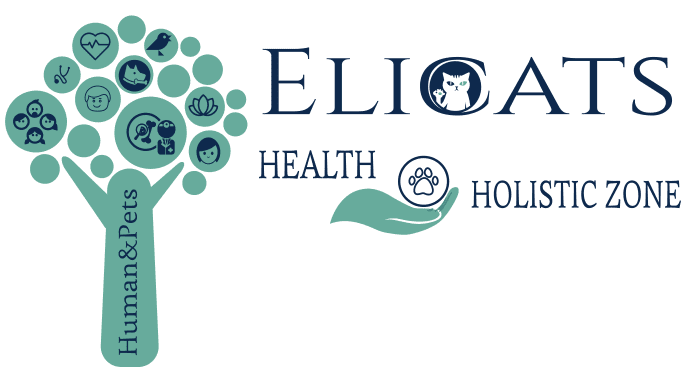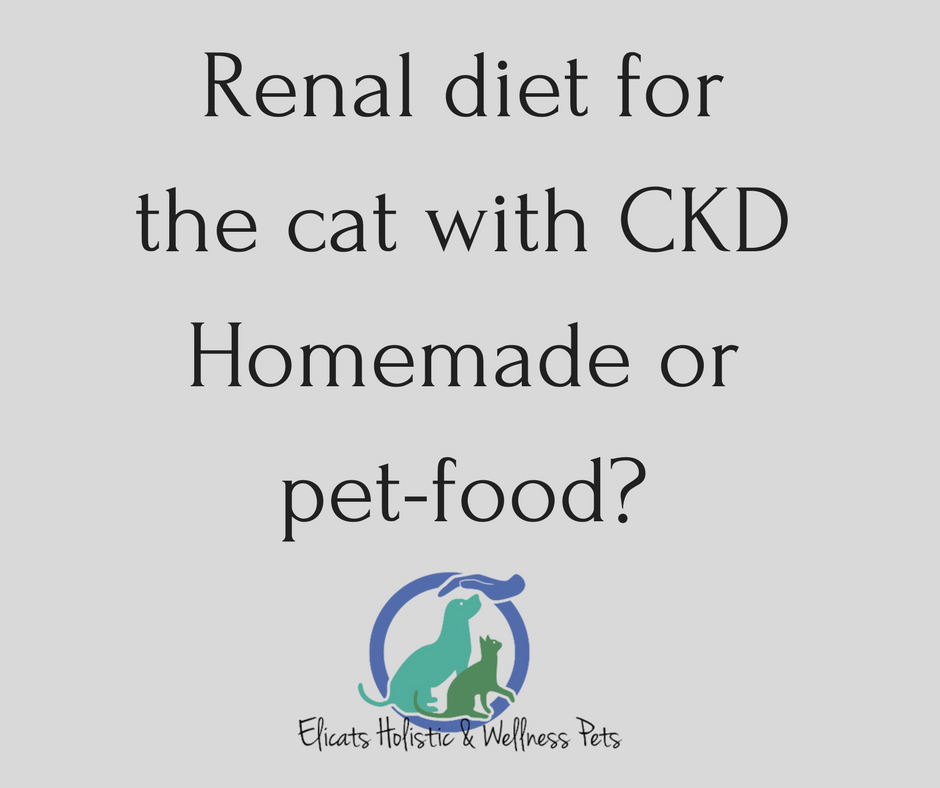Homemade food for cats with kidney disease when my cat became ill with chronic kidney disease (CKD) in addition to administration of the medicinal mushroom Cordyceps, the Protocol of Heel and different homeopathic remedies for lowering blood urea, basic holistic therapies for her, it was necessary to understand and focus nutritional appearance. What diet was more proper for my cat? a renal diet with reduced protein intake or a raw meat diet with added supplements punctuated perhaps by beef chicken and vegetables?
Great dilemma! network (it was 2011) as always I read articles on the management of nutrition in the course of renal failure in favor of a pet food medicated, studies and documents always and only on the preference of a renal diet for the cat, so with a reduced protein intake.
This article is solely the result of personal studies, research and experience, I remember you that on the web is good politeness respect the right to authorship of an article always quoting the source.
Thank you
Homemade food for cats with kidney disease who does not eat
It was important to have certainty in the food and definitely needed to know more, know the disease and I know how every day can be complicated to manage, in addition to well-specific symptoms you add the feed refusal factor common to many cats with CKD.
How many of us came together to look for solutions to counteract the loss of appetite, how many times I was told my cat refuses the renal food, do not eat canned, just sniffs the food, the renal diet is not appealing : cry:
Which adopt strategies, some advice

At critical periods
- Moldered the kibbles favorites and sprinkle on the renal food (preferably wet or homemade food)
- Add to renal diet for the cat a pet food A Conventional Renal those with an unpleasant smell!
- P Rovate new flavor enhancers LioMix Trainer or L es Filous Spices
Homemade food for cats with kidney disease
The food in my direction did was to choose a homemade diet with the addition of supplements, vitamins, acids Omega3 fats, Coenzyme Q10. The reason was simple and natural, I still wanted to assure adequate protein that would avoid muscle atrophy and loss of lean body mass and at the same time that could prevent and/or control the appetite. I began to create a weekly diet plan based homogenized homemade with the main ingredient albumen, a protein source that was definitely the case at our: BIOLOGICAL VALUE + 100 + GOOD BIOAVAILABILITY AMINO ACID DIGESTIBILITY ‘
The recipe with cooked egg white milkshake with a piece of chicken or turkey and pumpkin assured my cat a palatable and digestible meal!
Pumpkin for cats with kidney disease
For cats with stomatitis, diarrhea, or constipation, you can read all the special properties in the article PUMPKIN for the dog and cat, Beneficial properties Add recipe
DIET HOUSEWIFE, NEVER improvise!
If the cat does not eat and would like to work up an appetite a homemade diet should be followed by the vet. The diet of the cat and the formulation of the home renal diet should not leave room for improvisation. The homemade diet should in the same way that renal meet the power needs of the cat, relieve the clinical signs of kidney disease, reduce uremic poisoning, contain little sodium and phosphorus, and maintain the acid-base balance. Our diet should be individualized based on clinical and laboratory data.
My cat according to the Classification IRIS (International Renal Interest Society) was at one stage renal disease III – creatinine 251-440 micromol / L (2.9 – 5.0 mg / dl) then moderately impaired
Scelsi immediately a mostly home-made diet rolling his ingrendienti, ranging from protein sources and opting for proteins with a possible biological value close to the value 100 as the cooked egg white
The egg white is an excellent source of protein (each egg contains about 7 grams of protein, 5 of which nell’albume)
The biological value (VB) protein is a parameter, an index that describes how efficiently the body uses and metabolizes protein, organic meats have a high value but the FIRST PLACE is assigned to eggs, their amino acid profile and balance it is perfect and is taken as a reference for comparison of all other protein sources. The body is able to assimilate the protein or egg albumen in its entirety.
Homemade food for cats with kidney disease Loss of appetite from the uremic syndrome
During periods of poor appetite or when the symptoms of kidney disease were more insistent it offered the meal consists of the renal diet with added cooked albumen, during critical periods (due to stomatitis ), I administered a syringe every 2/3 hours just-food renal (not I added nor albumen nor other protein sources) + therapy Stomorgyl for 10/12 dd + water Fiuggi (administration of Fiuggi water syringe) to avoid dehydration and help at the same time to eliminate the nitrogenous waste.
While strictly Renal diet to assure all of the essential amino acids I integrated with a product of Guna in 2011 marketed under the name SON FORMULA today MAP
The cat’s body for optimal health requires approximately 20 amino acids, 11 of which are essential proteins must be digestible and at the same time with a high VB. The essential amino acids are : leucine, isoleucine, valine, tryptophan , phenylalanine, histidine, methionine, threonine, lysine, arginine and taurine .
The Gunamino Formula was once hired, following at 100% the way anabolic with the virtual absence of production of nitrogenous waste. The MAP (Master Amino Acid Pattern® a unique composition of essential amino acids in crystalline form, free, highly purified, was a blanket of an Italian Maurizio Luca Moretti, a researcher in the United States. And ‘he, in fact, that has achieved the goal coveted by many scientists working in the field of nutrition: find the perfect protein compound that is perfectly assimilated and bioavailable, which does not produce waste and toxins. the Map (Master Amino Acid Pattern) is a balanced association, catabolism pre-digested, and complete of the eight essential amino acids.: arrow: MAP ™ is the result of 23 years of research by the International Nutrition Research Center (INRC).
MAP produces less than 1% of nitrogen catabolites, the lowest in absolute value when compared to any food protein known: this prerogative makes it particularly suitable for those who have liver or kidney dysfunctions. Its use avoids the excess nitrogenous waste and consequently the overload of the kidneys.
- It is absorbed within minutes without digestive commitment
- It does not produce nitrogenous waste
- provides, in less weight and volume, the maximum value of protein compared to every other food
It has a Net Nitrogen Utilization (NNU) equal to 99%, ie that 99 parts are assimilated and a portion is excreted in the form of slag.
Gunamino Formula = Net Nitrogen (NNU) 99%
Egg = Net Nitrogen (NNU) 65%
Meat, Fish and Poultry = Net Nitrogen (NNU) 32%
TIPS: By now I take several years;) I go to an Off-Topic moment are important and useful info!
10 grams provide an equivalent nutritional value of protein per 450 grams of meat, fish, or poultry and add only 40 calories. It allows you to regain or retain the lean body mass while decreasing the fat. This product was subjected to an experiment double-blind, triple-crossover, which highlighted the lack of side effects, including those common to other amino acid associations, such as nausea, vomiting, abdominal cramps, and expansion. In this context it emerged its high nutritional value, it should be stressed that the digestion of proteins generally requires from three to about four hours, while the Map is absorbed in the small intestine in only twenty-two minutes. Indeed, it is pre-digested and does not require the intervention of ‘the peptidase enzyme, while needs a minimum stimulation of bile secretions, pancreatic and intestinal. This, together with its amphoteric characteristic (ie to be able to act as both acid and as a base, depending on the pH of the ‘environment in which it is located), makes it valuable for those who suffer from gastritis, digestive disorders, or IBD.
Chronic kidney failure in cats – The Renal Diet and protein restriction
 Premise: the renal diet for the cat should provide an adequate caloric intake, with a reduced content of sodium and phosphorus in order to optimize the renal function, blood pressure, and serum levels of potassium and phosphorus, it must provide sufficient energy to prevent the endogenous protein breakdown which results in malnutrition and exacerbation nitrogen. The energy needs of the cat are about 50 to 60 kcal/kg/day, although there is a variation of 25% considering the individual energy needs based on age, level of physical activity, concomitant diseases (cancer: arrow: v. cancer cachexia ) sterilization/castration.
Premise: the renal diet for the cat should provide an adequate caloric intake, with a reduced content of sodium and phosphorus in order to optimize the renal function, blood pressure, and serum levels of potassium and phosphorus, it must provide sufficient energy to prevent the endogenous protein breakdown which results in malnutrition and exacerbation nitrogen. The energy needs of the cat are about 50 to 60 kcal/kg/day, although there is a variation of 25% considering the individual energy needs based on age, level of physical activity, concomitant diseases (cancer: arrow: v. cancer cachexia ) sterilization/castration.
Can a renal diet to reduce kidney damage?
The protein restriction in cats with CKD remains a controversial issue and there are no studies in support, the renal diet can reduce the progression of renal damage, but it can limit the symptoms caused by the uremic syndrome, this is because the consumption of diets containing low levels protein reduces the amount of nitrogen waste and helps to decrease: polydipsia, polyuria, the urea signs such as vomiting, lethargy, anorexia, diarrhea, stomatitis, gastritis.
It can bring a heightened protein restriction metabolic disorders, lower immunity, and lead to other health complications?
The answer I think is yes, the cat is an obligate carnivore, it is clear that the renal diet for the cat does not slow kidney damage but relieves the typical symptoms of uremia, the dietary approach in chronic renal failure should necessarily vary depending on the state of health of the cat because the etiology of feline chronic renal disease is heterogeneous, includes specific disease processes that initiate kidney damage or kidney dysfunction, there are many diseases that cause organ damage PKD (kidney polycystic), renal amyloidosis, renal dysplasia, renal lymphoma, so the clinical manifestations of kidney disease can be varied and do not occur in all cats. : arrow: You have to identify, address, monitor, and customize medical and dietary management in each cat suffering from kidney disease.
Why is it important not to prescribe a renal diet for all cats either from the age, the stage of kidney disease (IRIS), or the illness?
Why not all cats are equal and the diseases that can affect the kidney we have seen may be different, the nutritional management needs to take into account several factors, such as whether the chronic renal failure is diagnosed at a young age rather cat that an older cat if the cat is symptomatic or not, take into account the values of BUN and CREA and / UC ratio, so the dietary approach should be formulated considering:
- Symptoms: There are sick cats with the uremic syndrome and a state of great intoxication usually the last stage of the disease who benefit from a diet with protein restriction, other cats in 1 -2 stage renal disease and young age that they should not follow to boost protein restriction because the cat is an obligate carnivore and needs of high biological value protein, taurine, and amino acids.
- Physical activity and other diseases in progress, a mono-cat to kidney hydronephrosis may have benefits in following a diet with protein restriction even at a young age. A cat with PKD (polycystic kidney disease) that has not yet developed kidney disease could very well follow a maintenance diet / Senior and switch to a renal diet when developing the ‘ chronic renal failure .
- Palatability and nutrition. If the cat refuses diet renal ABSOLUTELY MUST also eat pet food SENIOR but it should not stop eating, NO TO FAST, it is likely to enter a tunnel from which escape is difficult.
- Nutritional Standards, a renal diet usually does not meet the nutritional standar for an adult cat and should not be continued for long periods.
I think, very personal account it is clear that protein restriction become necessary in only 3 or 4 IRIS stage of the disease
The protein restriction should be undertaken with care, a renal diet in cats with CKD stage 1-2- protracted can be detrimental to your overall health
https://elicats.com/kidney-disease-cats-diet-recipes/

